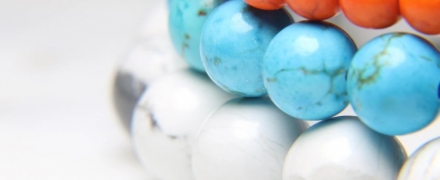open 10 am - 7 pm
laboratory is closed
Do not make turquoise out of howlite

Everyone knows the widespread imitations of turquoise from magnesite and howlite. And if the first is very rarely used in the manufacture of faceted stones in their natural form, then from the second, howlite, cabochons of a hidden or fine-grained structure are made. Howlite is used not only as an imitation of turquoise, but also as an independent jewelry and ornamental material, as well as for imitation of coral, which is less successful in comparison with turquoise, from which it is easily distinguished by the absence of growth structures. Individual grains and crystals of howlite are white to gray or completely colorless. For cabochons, a cryptocrystalline aggregate of white or light gray color is used, transparent varieties of howlite in the form of crystals are used as collectible mineralogical material. This mineral got its name not because of the disappointment of unlucky buyers of imitations of turquoise, but after the name of the English naturalist from Canada - Henry How (1828-1879), who in 1868 first described this mineral as "silicoborocalcite". In accordance with different classifications, howlite was classified as either borates or silicates. Currently, it has found its place in the subclass of non-silicates (insular calcium borosilicate with hydroxyl ion).
В геммологической практике бывают весьма увлекательные случаи с диагностикой ювелирных вставок
Но помимо редкости цвета и высокой стоимости таких камней, многие розовые камни выделяются одной замечательной особенностью – они проявляют плеохроизм, то есть в зависимости от положения осмотра камня он может иметь дополнительные оттенки – оранжевый или пурпурный.
Currently, gemstones are produced by two fundamentally different technological methods - the High Pressure - High Temperature method (“HPHT”, High-pressure & High-temperature) and the Chemical Vapor Deposition (“CVD”, Chemical vapor deposition) method. The "HPHT" method is the most tested classical synthesis method, which can be used both carbon deposition on diamond from flux melts and catalytic reactions. In "CVD" synthesis, diamond growth occurs on a seed during carbon deposition mainly from a gaseous medium at relatively low temperatures and pressures.
Jewelry and precious stones are just such a category of goods, when buying which you need to pay attention to many criteria.
Sogdianite is a rather rare mineral and more often it can be found as a collection material (moreover, in systematic collections), and it is extremely rare in jewelry.






